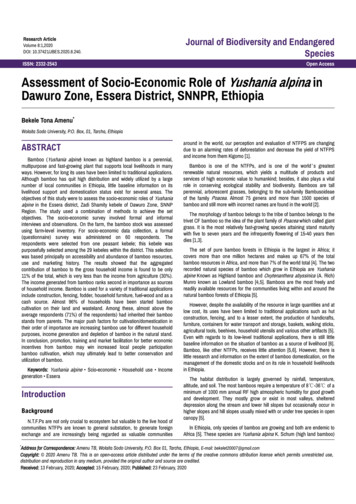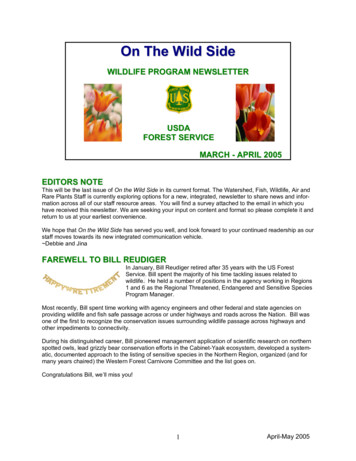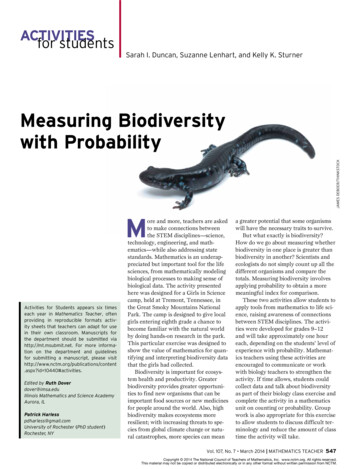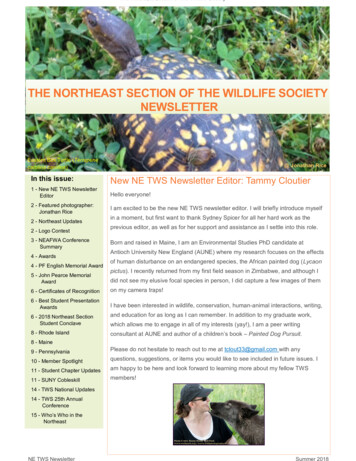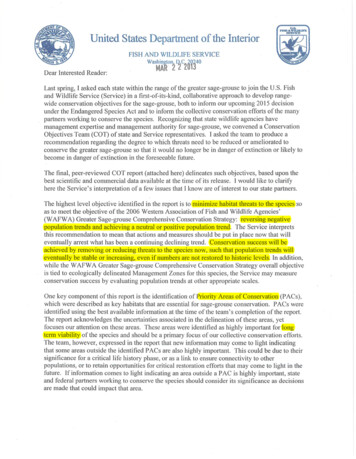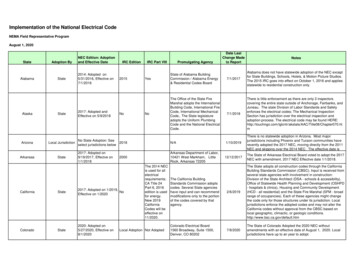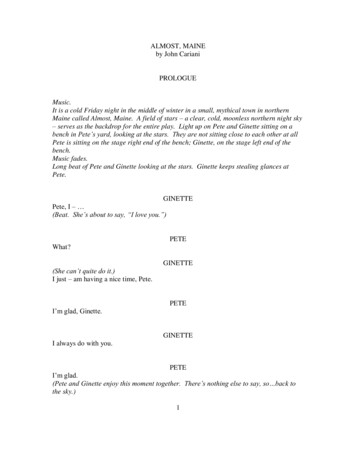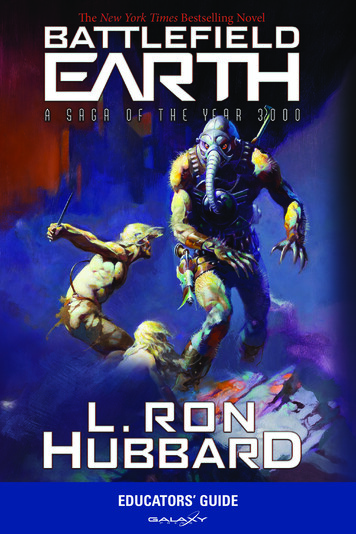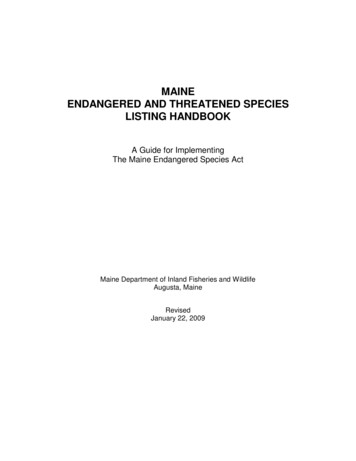
Transcription
MAINEENDANGERED AND THREATENED SPECIESLISTING HANDBOOKA Guide for ImplementingThe Maine Endangered Species ActMaine Department of Inland Fisheries and WildlifeAugusta, MaineRevisedJanuary 22, 2009
Maine E&T Species Listing Handbook 2006CONTENTSPurpose3Definitions5Listing Categories7Listing Procedures and Qualifications8Listing Guidelines11AppendicesA.Maine Endangered Species Act19B.Maine Endangered Species Act – Related Rules27C.Species Listing Review Worksheet40D.Species Listing Recommendation Form442
Maine E&T Species Listing Handbook 2006PURPOSEThis Handbook is intended to serve as a guide in recommending species to the MaineLegislature for inclusion on Maine’s Endangered and Threatened Species lists. Itspurpose is to provide a comprehensive and biologically based system that identifiesspecies in danger of extirpation from Maine, and to serve as a guide for assigning thosespecies to categories relative to their probabilities of extinction from Maine.The Maine Endangered Species Act (MESA) gives the Commissioner the authority tomake recommendations for listing and for maintaining a list of species that are at risk ofbecoming extinct in Maine. The purpose of MESA is stated in the Act.§12801. Declaration of purposeThe Legislature finds that various species of fish or wildlife have been and are in dangerof being rendered extinct within the State of Maine, and that these species are of esthetic,ecological, educational, historical, recreational and scientific value to the people of theState. The Legislature, therefore, declares that it is the policy of the State to conserve, byaccording such protection as is necessary to maintain and enhance their numbers, allspecies of fish or wildlife found in the State, as well as the ecosystems upon which theydepend.Listing of a species, and the subsequent management of that species, are two distinctsteps.1. Listing – Listing is the structured, systematic, and scientific examination of theinteracting factors that qualifies a species as a candidate for listing as anEndangered or Threatened species in Maine.2. Management – The listing of a species (in any category) does not automaticallyensure a given level of management, nor does it automatically commit resourcesor programs for that species. Those commitments are part of a subsequent andseparate step to the listing process.Separating these two steps allows the Department to recommend species for listingbased solely on biological facts, thus purely reflecting the species' likelihood ofextinction within Maine. The decision can be made without being constrained by politicalpressures; limits on agency funding, staffing, or management capabilities; the ease ordifficulty of managing a species; or by a species’ potential responsiveness or lack ofresponsiveness to management.By having a second step, more thoughtful and refined management decisions arepossible. The feasibility, desirability, and practicality of management options can beconsidered during the second step, along with the management and regulatoryjurisdictions of other state, tribal, and federal agencies. This second step is addressedprimarily in MDIFW’s species planning process as outlined in Maine’s ComprehensiveWildlife Conservation Strategy (2005).3
Maine E&T Species Listing Handbook 2006In summary, the first step recognizes and documents biological concerns for a speciesby listing it in one of four categories, and the second step looks pragmatically atprograms for its protection and recovery. This Handbook addresses the first step.This Handbook covers all aspects of the Department's Endangered Species Listingprocess, including both regulatory and policy level components. The Maine EndangeredSpecies Act statutorily establishes the categories of "Endangered" and "Threatened”species. Species are added to, or deleted from, these categories via recommendationsby the Commissioner of MDIFW to the Legislature, and ultimately, approval by theLegislature. Other administrative categories (Special Concern and Extirpated) areestablished by policy, not by regulation, and are used for planning and informationalpurposes; they do not have the legal weight of the first two categories.4
Maine E&T Species Listing Handbook 2006DEFINITIONSStatutory Definitions:Title 12, Chapter 901: DEFINITIONS (HEADING: PL 2003, c. 414, Pt. A, @2 (new);Pt. D, @7 (aff); c. 614, @9 (aff))§10001. DefinitionsAs used in this Part, unless the context otherwise indicates, the following terms have thefollowing meanings. [2003, c. 414, Pt. A, §2 (new); c. 614, §9 (aff).]19. Endangered species. "Endangered species" means a species of fish or wildlife that has beendetermined by the commissioner to be in danger of extinction throughout all or a significantportion of its range and that is listed as a state endangered species under section 12803,subsection 3. [2003, c. 414, Pt. A, §2 (new); c. 614, §9 (aff).]22. Fish, the noun. "Fish" means a cold-blooded, completely aquatic vertebratecharacteristically having gills, fins and an elongated streamlined body usually covered withscales and includes any physical part of a fish. The term refers to fish living predominantly ininland waters and to anadromous and catadromous fish while in inland waters. Whenever thename of a fish, such as "bass" or "trout," is used, it means the named fish or any of its physicalparts. [2003, c. 614, §9 (aff); c. 655, Pt. B, §5 (amd); §422 (aff).]62. Threatened species. "Threatened species" means a species of fish or wildlife that has beendetermined by the commissioner as likely to become an endangered species within theforeseeable future throughout all or a significant portion of its range and that is listed as a statethreatened species under section 12803, subsection 3. [2003, c. 414, Pt. A, §2 (new); c. 614, §9(aff).]69. Wild animal. "Wild animal" means a species of mammal, wild by nature, whether or notbred or reared in captivity, as distinguished from the common domestic animals, and includes anyphysical part of that species of animal. Whenever the name of a wild animal, such as "deer" or"bear," is used, it means the named wild animal or any of its physical parts. [2003, c. 414, Pt. A,§2 (new); c. 614, §9 (aff).]70. Wild bird. "Wild bird" means a species of bird wild by nature, whether or not bred orreared in captivity, as distinguished from common domestic birds, and includes any physical partof that species of bird. Whenever the name of a wild bird, such as "pheasant" or "eagle," is used,it means the named wild bird or any of its physical parts. [2003, c. 414, Pt. A, §2 (new); c. 614,§9 (aff).]71. Wildlife. "Wildlife" means any species of the animal kingdom, except fish, that is wild bynature, whether or not bred or reared in captivity, and includes any part, egg or offspring of theanimal, or the dead body or parts of the animal. "Wildlife" includes wild animals and wild birds.[2003, c. 414, Pt. A, §2 (new); c. 614, §9 (aff).]5
Maine E&T Species Listing Handbook 2006Other Definitions as used in this Handbook:Discrete: Distinct and separable.Disjunct: Distinctly separate where potentially interbreeding populations are separatedfrom each other by sufficient distance to preclude consistent gene flow (e.g. 1successful migrant per generation).Endemic: Native to, and restricted to, a particular geographic area.Generation: The average duration of a life cycle between birth and first reproduction.Immigration Rate: The rate at which individuals are added to a population throughinterchange with other populations.Migratory: A species having periodic or seasonal movements in or out of Maine.Northeast: The glaciated northeastern states and provinces, including New England,New York, northeastern Pennsylvania, northwestern New Jersey, Maritime Canada, andsouthern Quebec ( southeast of the St. Lawrence River)Population: All individuals of the species or subspecies, statewide, unless otherwisespecified.Population Viability Analysis: A set of estimates that are the product of a systematicprocess for estimating species-, location-, and time-specific criteria for persistence.Species: Means species or subspecies.Vagrant: A species that occurs infrequently in Maine, but has not established a patternof spending some portion of its annual cycle in Maine, including breeding, migration, orwintering.6
Maine E&T Species Listing Handbook 2006LISTING CATEGORIESFour categories are established to implement Maine's Endangered Species Act:Endangered, Threatened, Special Concern, and Extirpated. Endangered andThreatened are established and named by statute. Special Concern and Extirpatedare established administratively.Brief definitions of the four categories follow. Detailed guidelines for assigning speciesto these categories are presented in the remaining sections of this Handbook.Endangered Species: “.a species of fish or wildlife that has been determinedby the commissioner to be in danger of extinction throughout all or a significantportion of its range and that is listed as a state endangered species undersection 12803, subsection 3.”Threatened Species: “ a species of fish or wildlife that has been determinedby the commissioner as likely to become an endangered species within theforeseeable future throughout all or a significant portion of its range and that islisted as a state threatened species under section 12803, subsection 3.”Special Concern Species: Any species of fish or wildlife that does not meet thecriteria as Endangered or Threatened but is particularly vulnerable, and couldeasily become, an Endangered, Threatened, or Extirpated species due torestricted distribution, low or declining numbers, specialized habitat needs orlimits, or other factors.Extirpated Species: Any species that was at one time indigenous to Maine buthas not been documented as occurring in Maine for the past 50 years, and therehas been a reasonable effort to find that species.7
Maine E&T Species Listing Handbook 2006LISTING PROCEDURES AND QUALIFICATIONSMDIFW has the responsibility of maintaining a current and accurate listing of species indanger of extirpation from Maine. This section of the Handbook documents theDepartment's procedures for periodic reviews or requests to add, remove, or changeListed Species. The Maine ESA and related Department Rules, establish the authorityand criteria for listing. The enabling statutes are under 12 MRSA, which include thefollowing (For complete text, refer to Appendix A).§12803. Designation of endangered species1. Standards. The commissioner shall recommend a species to be listed as endangered orthreatened whenever the commissioner finds one of the following to exist:A. The present or threatened destruction, modification or curtailment of its habitat or range;B. Overutilization for commercial, sporting, scientific, educational or other purposes;C. Disease or predation;D. Inadequacy of existing regulatory mechanisms; orE. Other natural or manmade factors affecting its continued existence within the State.2. Commissioner's duties. In recommending a species to be listed as endangered or threatened,the commissioner shall:A. Make use of the best scientific, commercial and other data available;B. Consult, as appropriate, with federal agencies, other interested state agencies, otherstates having a common interest in the species and interested persons and organizations;andC. Maintain a list of all species that the Legislature has designated to be endangered orthreatened, naming each species by both its scientific and common name, if any, andspecifying over what portion of its range each species so designated is endangered orthreatened.3. Legislative authority. The Legislature, as sole authority, shall designate a species as a stateendangered or state threatened species. The list of state endangered or state threatenedspecies by common name, scientific name and status is as follows:4. Process for recommendation; notice and hearings. Prior to recommending an addition,deletion or other change to the endangered and threatened species listed in subsection 3, thecommissioner shall provide for public notice and public hearings on that proposedrecommendation in accordance with the provisions of Title 5, chapter 375, subchapter 2.5. Designation by Legislature. The Legislature may not amend the list of endangered orthreatened species in subsection 3 except upon the recommendation of the commissioner.8
Maine E&T Species Listing Handbook 2006The following are exerpts from MDIFW Rules (09-137 Department of Inland Fisheriesand Wildlife, Chapter 8: Endangered Species) (For complete text, refer to Appendix B).8.01 Agency JurisdictionA. The Commissioner has the authority to recommend to the Legislature the designation of anyspecies of fish or wildlife found in the State as endangered or threatened in accordance withthe provisions of the Maine Endangered Species Act. The Legislature has sole authority todesignate a species as endangered or threatened.B. When IF&W has overlapping jurisdiction with another state agency for a species (i.e. theAtlantic Salmon Authority and Atlantic salmon or the Department of Marine Resources andmarine mammals, marine turtles, marine fish, marine invertebrates, and anadromous andcatadromous species other than Atlantic salmon when in tidal waters), or another stateagency has primary responsibility for a species (i.e. marine fish), IF&W will not recommendthat species as threatened or endangered until the agency with overlapping or primaryjurisdiction has reviewed the listing request.8.02Designation of Endangered and Threatened SpeciesA. In determining whether a species meets one or more of the standards for designating aspecies as endangered or threatened as listed in 12 M.R.S.A. §7753(1), qualifications forconsideration for listing, population guidelines for risk of extinction, and other factors willbe considered. For the purposes of this chapter, "species" will mean "species" or"subspecies" and "populations" will mean all individuals of the species, statewide.1. Qualifications for Consideration for ListingA species may only be recommended for listing as a state endangered or threatenedspecies if it meets all of the following qualifications:a. it is a species of mammal, bird, fish, amphibian, reptile, or invertebrate wild bynature as distinguished from domestic species;b. it is an indigenous species to Maine, meaning it is not an exotic deliberately oraccidentally introduced into Maine, the United States, or North America;c. it is a species that spends some portion of its annual cycle in Maine, includingbreeding, migration, or wintering, but is not a vagrant or accidental visitor;d. it is a species that has not expanded into Maine within the past 50 years as part of ageneral range expansion, unless it historically occurred in Maine or is threatened ordeclining throughout a significant portion of its total range;e. it is a species that has not been reintroduced into Maine as part of an experimentalwildlife management program, unless listing is part of the reintroduction plan; andf. it is taxonomically classified no finer than a subspecies, unless federally Endangeredor Threatened.9
Maine E&T Species Listing Handbook 20063. Other FactorsIn addition to population guidelines (2) above, other factors, including range or habitatloss, disease, predation, over-utilization, inadequacy of regulations, and other natural orhuman-related factors as measured through observation, inference, or projection, will beconsidered when determining whether to recommend a species for listing as Endangeredor Threatened as provided in 12 M.R.S.A. §7001 (7 and 36).B. Review of List1. At least every 5 years, the Department shall initiate a review of the designation of speciesas Endangered or Threatened to determine if any species should be recommended to beadded to, deleted from, or changed between the lists.2. Requests to add, change, or remove species on the lists may be submitted to theCommissioner for review and recommendation at any time.C. Prior to recommending an addition, deletion or other change to the endangered and threatenedspecies list, the Commissioner shall provide for public notice and public hearings on theproposed recommendation in accordance with the provisions of Title 5, chapter 375,subchapter II.The decision as to whether to designate a species as Endangered, Threatened, SpecialConcern, or Extirpated shall be done in accordance with the Maine Endangered SpeciesAct, other statutes and regulations of the State of Maine and the Maine Department ofInland Fisheries and Wildlife, and shall be guided by the criteria and guidelinespresented in this handbook.10
Maine E&T Species Listing Handbook 2006LISTING GUIDELINESThe listing of a species in Maine is an indication that its risk of extinction from Maine isgreat enough to warrant concern and recognition. The listing category to which aspecies is assigned is a reflection of the relative magnitude of that species probability ofextinction from Maine.Step 1Before a species is considered for listing, it must be determined if the species isqualified for listing as established in rule (refer to page 9). The species must meet all ofthe following qualifications. It is a species of mammal, bird, fish, amphibian, reptile, or invertebrate wild bynature as distinguished from domestic species; It is an indigenous species to Maine, meaning it is not an exotic deliberately oraccidentally introduced into Maine, the United States, or North America; It is a species that spends some portion of its annual cycle in Maine, includingbreeding, migration, or wintering, but is not a vagrant or accidental visitor; It is a species that has not expanded into Maine within the past 50 years as part ofa general range expansion, unless it historically occurred in Maine or isthreatened or declining throughout a significant portion of its total range; It is a species that has not been reintroduced into Maine as part of anexperimental wildlife management program, unless listing is part of thereintroduction plan; and It is taxonomically classified no finer than a subspecies, unless federallyEndangered or Threatened.Guidelines for Migratory Secies that do not Breed in MaineSome migratory species occur in low numbers in Maine during their non-breedingseason. For many of these species, their rarity in Maine is a function of variations inecological conditions (e.g. winter severity, peripheral migration routes, prey abundance).Such species will not be considered for listing under the Maine Endangered Species Actsolely by virtue of their small population size, unless their occurrence is also jeopardizedby one or more factors in Maine related to distribution (e.g. clustered occurrence, highsite fidelity), fragmentation, broader population declines, inadequate regulations, etc.Migrants that occur strictly as rare transients in Maine are valued as part of the state’swildlife diversity, but there is little conservation benefit from state listing, because theiroccurrence is largely dependent on movements from source populations in jurisdictionsbeyond the realm of the Maine ESA.11
Maine E&T Species Listing Handbook 2006Step 2The following criteria are to be considered when recommending species for listing inMaine and the assignment of category. The specific numbers cited are to be used asguidelines. The ultimate recommendation regarding listing status shall be based on thebest available scientific information.Extirpated Species: A species will be listed as extirpated if it was at one timeindigenous to Maine but has not been documented as occurring in Maine for the past 50years, and a reasonable effort has been made to find the species.12
Maine E&T Species Listing Handbook 2006Endangered Species: A species will be considered for listing as Endangered if:A. The following criterion is met:Population Modeling: A population viability analysis of the species yields a 30%probability of extirpation from Maine within 20 years or 10 generations, whichever islonger (up to a maximum of 100 years); ORB. Any two of the following five criteria are met, statewide, in Maine:1.Population Size:Vertebratesa) It is a non-migratory or otherwise isolated population, and the total populationis estimated at 500 individuals or the breeding population at 200; ORb) It is a migratory or otherwise non-isolated population, and the total populationis estimated at 250 individuals or the breeding population at 100.Invertebratesa) It is a non-migratory or otherwise isolated population, and the breedingpopulation is estimated at 1,000 individuals; ORb) It is a migratory or otherwise non-isolated population, and the breedingpopulation is estimated at 500 individuals.2.Population Trend:a) After allowing for normal fluctuations, an observed, estimated, or inferredpopulation decline of 50% has occurred within the past 10 years or 3generations (whichever is longer), or 75% within the past 40 years or 9generations (whichever is longer); and is continuing to decline, ORb) After allowing for normal fluctuations, an observed, estimated, or inferreddecline in reproductive success or recruitment of young into the breeding agepopulation of 50% has occurred within the past 10 years or 3 generations(whichever is longer), or 75% within the past 40 years or 9 generations(whichever is longer).13
Maine E&T Species Listing Handbook 20063. Population Distribution: 90% of the population is found at 5 discrete, disjunct sitesduring any portion of the species’ annual life cycle.4. Population Fragmentation: The population is non-migratory or otherwise isolated(immigration rate 1 per year); its distribution is fragmented such that it occurs indiscrete, disjunct sites; and there are 2 of those sites with known or estimated totalpopulations of 250 individuals (vertebrates) or breeding populations of 500 individuals(invertebrates).5. Endemism: The species is entirely or largely endemic to Maine and/or is assigned aNatureServe global rarity rank of “Critically Imperiled” (G1 for species; T1 forsubspecies); ORC. One or more factors including range or habitat loss, disease, predation, over-utilization,inadequacy of existing regulations, or other natural or human-related factors leading,through observation, inference, or projection to a very high probability of extinction(extirpation from the state) within 100 years.14
Threatened Species: A species will be considered for listing as Threatened if it does not meetthe criteria for listing as Endangered and:A. The following criterion is met:Population Modeling: A population viability analysis of the species yields a 20% probabilityof extirpation from Maine within 30 years or 10 generations, whichever is longer (up to amaximum of 100 years); ORB. Any one of B.1, B.2, B.3, or B.4, under "Endangered" are met; {if listing is to be based solelyon declining trend (B.2), and trend is from the North American Breeding Bird Survey, list asSpecial Concern if: (1) there are too many individuals or occurrences to meet the “spirit” ofThreatened status, or (2) there is no defensible estimate of the number of individuals oroccurrences (i.e., no data to support a total population of 500 individuals or a breedingpopulation of 200)}, ORC. Any two of the following five criteria are met:1. Population Size:Vertebratesa) It is a non-migratory or otherwise isolated population, and the total population isestimated at 1,000 individuals or the breeding population at 400; ORb) It is a migratory or otherwise non-isolated population, and the total population isestimated at 500 individuals or the breeding population at 200.Invertebratesa) It is a non-migratory or otherwise isolated population, and the breeding population isestimated at 3,000 individuals; ORb) It is a migratory or otherwise non-isolated population, and the breeding population isestimated at 1,500 individuals.2. Population Trend:a) After allowing for normal fluctuations, an observed, estimated, or inferred populationdecline of 25% has occurred within the past 10 years or 3 generations (whicheveris longer) 50% within the past 40 years or 9 generations (whichever is longer); ORb) After allowing for normal fluctuations, an observed, estimated, or inferred decline inreproductive success or recruitment of young into the breeding age population 25%has occurred within the past 10 years or 3 generations (whichever is longer), or 50% within the past 40 years or 9 generations (whichever is longer).3. Population Distribution: 90% of the population is found at 8 discrete, disjunct sitesduring any portion of the species’ annual life cycle.15
4. Population Fragmentation: The population is non-migratory or otherwise isolated(immigration rate 1 per year); its distribution is fragmented such that it occurs indisjunct, discrete sites; and there are 5 of those sites with known or estimated totalpopulations of 250 individuals (vertebrates) or breeding populations of 500 individuals(invertebrates).5. Endemism: The species is entirely or largely endemic to Maine and/or is assigned aNatureServe global rarity rank of “Imperiled” (G2 for species; T2 for subspecies); ORD. One or more factors including habitat or range loss, over-utilization, disease, predation,inadequacy of existing regulations, or other natural or human-related factors leading, throughobservation, inference, or projection to a high probability of extinction (extirpation from Maine)within 100 years.16
Special Concern Species: A species will be considered for listing as Special Concern if itdoes not meet the criteria for listing as Endangered or Threatened and:A. Any one of C.1, C.2, C.3, or C.4 under “Threatened” are met; ORB. Population Modeling: A population viability analysis of the species yields a 10% probabilityof extirpation from Maine within 100 years; ORC. Any two of the following criteria are met:1. Population Size:Vertebratesa) It is a non-migratory or otherwise isolated population, and the total population isestimated at 2,000 individuals or the breeding population at 800; ORb) It is a migratory or otherwise non-isolated population, and the total population isestimated at 1,000 individuals or the breeding population at 400.Invertebratesa) It is a non-migratory or otherwise isolated population, and the breeding population isestimated at 10,000 individuals ; ORb) It is a migratory or otherwise non-isolated population, and the breeding population isestimated at 5,000 individuals.2. Population Trend:a) After allowing for normal fluctuations, an observed, estimated, or inferred populationdecline of 25% has occurred within the past 20 years or 6 generations (whicheveris longer), or 50% within the past 80 years or 12 generations (whichever is longer);ORb) After allowing for normal fluctuations, an observed, estimated, or inferred decline inreproductive success or recruitment of 25% has occurred within the past 20 yearsor 6 generations (whichever is longer), or 50% within the past 80 years or 12generations (whichever is longer).3. Population Distribution: 90% of the population is found at 12 discrete, disjunct sitesduring any portion of the species’ annual life cycle.4. Population Fragmentation: The population is non-migratory or otherwise isolated(immigration rate 1 per year); its distribution is fragmented such that it occurs indisjunct, discrete sites; and there are 8 of those sites with known or estimated totalpopulations of 500 individuals (vertebrates) or breeding populations of 1,000individuals (invertebrates).5. Endemism: The species is endemic to the Northeast and/or is assigned a NatureServeglobal rarity rank of “Vulnerable” (G3 for species; T3 for subspecies);17
6. Federal Status: The species is listed as Endangered, Threatened, or Special Concernunder the Federal ESA; ORD. One or more factors including habitat or range loss, over-utilization, disease, predation,inadequacy of existing regulations, or other natural or human-related factors leading,through observation, inference, or projection to a moderate probability of extinction(extirpation from Maine) within 100 years.18
APPENDIX AMaine Endangered Species Act19
The Maine Endangered Species ActState of Maine, Inland Fisheries and Wildlife LawsTitle 12, CHAPTER 925Subchapter 3: ENDANGERED SPECIES; MANAGEMENT AND RESEARCH (HEADING: PL 2003, c.414, Pt. A, @2 (new); Pt. D, @7 (aff); c. 614, @9 (aff))12 §12801. DECLARATION OF PURPOSEThe Legislature finds that various species of fish or wildlife have been and are in danger of being renderedextinct within the State of Maine, and that these species are of esthetic, ecological, educational, historical,recreational and scientific value to the people of the State. The Legislature, therefore, declares that it is the policy ofthe State to conserve, by according such protection as is necessary to maintain and enhance their numbers, all speciesof fish or wildlife found in the State, as well as the ecosystems upon which they depend. [2003, c. 414, Pt.A, §2 (NEW); 2003, c. 614, §9 (AFF).]This subchapter and chapter 631 are established to carry out the purposes of this section. [2003, c. 573,§5 (NEW); 2003, c. 573, §8 (AFF); 2003, c. 655, Pt. C, §§3, 6 (AFF).]SECTION HISTORY2003, c. 414, §A2 (NEW). 2003, c. 573, §5 (AMD). 2003, c. 414, §D7 (AFF).2003, c. 573, §8 (AFF). 2003, c. 614, §9 (AFF). 2003, c. 655, §§C3,6 (AFF).12 §12802. COMMISSIONER'S AUTHORITY, INVESTIGATIONS AND PROGRAMS1. Investigations. The commissioner may conduct investigations in order to develop information relating topopulation size, distribution, habitat needs, limiting factors and other biological and ecological data relating to thestatus and requirements for survival of any species of fish or wildlife occurring in the State, whether endangered ornot.[ 2003, c. 655, Pt. B, §308 (AMD);B, §422 (AFF) .]2003, c. 614, §9 (AFF);2003, c. 655, Pt.2. Programs. The commissioner may develop programs to
process for estimating species-, location-, and time-specific criteria for persistence. Species: Means species or subspecies. Vagrant: A species that occurs infrequently in Maine, but has not established a pattern of spending some portion of its annual cyc
